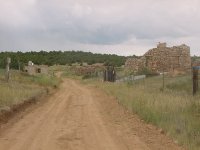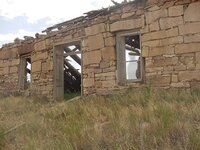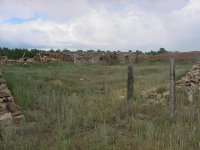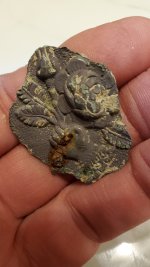Gypsy Heart
Gold Member
In 1850, Lieutenant Colonel E. V. Sumner took his first look at the U.S. troops stationed in Santa Fe and the temptations offered to soldiers there.
He immediately determined to remove them from "that sink of vice and extravagance" by establishing forts only in remote areas.
The plains near La Junta seemed a likely spot since the Santa Fe Trail came across there from Independence, Missouri. And, thankfully, no large towns could deter the soldiers from their duties. Loma Parda (Grey Hill), a small fanning community six miles away, was the closest town.
Soldiers didn't need a town, however, to bring them some of the delights that had been available in Santa Fe. Hardly had Fort Union been completed in 1851 when a group of prostitutes established
their trade in nearby caves.
A Captain Sykes ended the sinful practice by capturing the women and shaving their heads; the caves now are a part of Cafion de Las Pelones, Baldwomen's Canyon.
But enterprising merchants in Loma Parda realized that what caves could provide, houses could provide better--or at least in more comfort. The town became what is called a "blow off' town, where the soldiers would go to gamble, dance, drink, and carouse with women. An officer named Hollister dubbed the place "a sodom," allowing Ralph Looney, in Haunted Highways, to make a memorable biblical pun by calling Loma Parda "Sodom on the Mora."
The Mora River did indeed run freely near Loma Parda, but it was Loma Lightning, a vicious whisky, that ran freely through the town. Hollister complained that the fort's guardhouse and hospital were filled with men who met up with the Lightning. Julian Baca's dance hall featured live music twenty four hours a day, and the thriving bordellos gave an ironic meaning to the name of the fort.
Commanding officers tried various ploys to keep soldiers away, usually by making the town strictly off limits. The most ingenious idea considered was to lease the whole town and then destroy it. But by 1872 Loma Parda had become a town of over four hundred, with its own post office. There was at least one establishment, the McMartin brothers' mercantile, that did legitimate business with the fort itself. Mainly, however, the offerings of the town were meant for the wayward soldiers. In addition to the brothels and bars were pool halls and dance halls that served a variety of libations, even champagne. Wagon service to the fort was available for one dollar per round trip, but that was far too expensive for the average soldier.
Two stories will serve to illustrate the violence and rowdiness of Loma Parda. One night in 1882 a soldier named James Gray was murdered in town. His friends at Fort Union went AWOL
dressed as cowboys and attended a dance at Loma Parda. By infiltrating and asking the right questions, they ascertained the murderer, "invited" him outside, and hanged him.
Then there was James Lafer's visit in 1888. He rode into town, hauled a woman up into the saddle with him by dragging her across his horse, and rode right into a saloon. When his horse would not drink any liquor, he summarily shot it in the head, grabbed the woman, and exited, leaving the horse dead on the barroom floor. Many other anecdotes exist about Loma Parda, the best in Lloney's book and in a pamphlet called The Loma Parda Story by E Stanley.
When the importance of Fort Union began to fade, so did Loma Parda. The post once lasted until 1900, or nine years after the fort was abandoned. A few families kept farming in the area, but by World War II it had been abandoned entirely. The only bridge into town washed away in 1948 and has never been replaced. A footbridge now provides access to the town.
Watrous and Loma Parda
Two isolated towns were at one time important stops on the Santa Fe Trail, albeit for very different reasons! Today, Watrous, just off of I-25 in southernmost part of Mora County, is a roadside hamlet. Early travelers on the Santa Fe Trail knew it as La Junta, because it was located at the confluence of the Mora and Sapello Rivers. From Watrous to Wagon Mound, some of the finest Santa Fe Trail ruts are visible from the access road northeast of the I-25 exit-366. Six miles northwest of Watrous, on Hwy 161 traveling toward Ft. Union, is the ghost town of Loma Parda, once known as "Sodom on the Mora." It started out as a small, respectable farming and sheepherding community, but when Fort Union opened, it became a rendezvous for soldiers on leave and traders from the Santa Fe Trail.
He immediately determined to remove them from "that sink of vice and extravagance" by establishing forts only in remote areas.
The plains near La Junta seemed a likely spot since the Santa Fe Trail came across there from Independence, Missouri. And, thankfully, no large towns could deter the soldiers from their duties. Loma Parda (Grey Hill), a small fanning community six miles away, was the closest town.
Soldiers didn't need a town, however, to bring them some of the delights that had been available in Santa Fe. Hardly had Fort Union been completed in 1851 when a group of prostitutes established
their trade in nearby caves.
A Captain Sykes ended the sinful practice by capturing the women and shaving their heads; the caves now are a part of Cafion de Las Pelones, Baldwomen's Canyon.
But enterprising merchants in Loma Parda realized that what caves could provide, houses could provide better--or at least in more comfort. The town became what is called a "blow off' town, where the soldiers would go to gamble, dance, drink, and carouse with women. An officer named Hollister dubbed the place "a sodom," allowing Ralph Looney, in Haunted Highways, to make a memorable biblical pun by calling Loma Parda "Sodom on the Mora."
The Mora River did indeed run freely near Loma Parda, but it was Loma Lightning, a vicious whisky, that ran freely through the town. Hollister complained that the fort's guardhouse and hospital were filled with men who met up with the Lightning. Julian Baca's dance hall featured live music twenty four hours a day, and the thriving bordellos gave an ironic meaning to the name of the fort.
Commanding officers tried various ploys to keep soldiers away, usually by making the town strictly off limits. The most ingenious idea considered was to lease the whole town and then destroy it. But by 1872 Loma Parda had become a town of over four hundred, with its own post office. There was at least one establishment, the McMartin brothers' mercantile, that did legitimate business with the fort itself. Mainly, however, the offerings of the town were meant for the wayward soldiers. In addition to the brothels and bars were pool halls and dance halls that served a variety of libations, even champagne. Wagon service to the fort was available for one dollar per round trip, but that was far too expensive for the average soldier.
Two stories will serve to illustrate the violence and rowdiness of Loma Parda. One night in 1882 a soldier named James Gray was murdered in town. His friends at Fort Union went AWOL
dressed as cowboys and attended a dance at Loma Parda. By infiltrating and asking the right questions, they ascertained the murderer, "invited" him outside, and hanged him.
Then there was James Lafer's visit in 1888. He rode into town, hauled a woman up into the saddle with him by dragging her across his horse, and rode right into a saloon. When his horse would not drink any liquor, he summarily shot it in the head, grabbed the woman, and exited, leaving the horse dead on the barroom floor. Many other anecdotes exist about Loma Parda, the best in Lloney's book and in a pamphlet called The Loma Parda Story by E Stanley.
When the importance of Fort Union began to fade, so did Loma Parda. The post once lasted until 1900, or nine years after the fort was abandoned. A few families kept farming in the area, but by World War II it had been abandoned entirely. The only bridge into town washed away in 1948 and has never been replaced. A footbridge now provides access to the town.
Watrous and Loma Parda
Two isolated towns were at one time important stops on the Santa Fe Trail, albeit for very different reasons! Today, Watrous, just off of I-25 in southernmost part of Mora County, is a roadside hamlet. Early travelers on the Santa Fe Trail knew it as La Junta, because it was located at the confluence of the Mora and Sapello Rivers. From Watrous to Wagon Mound, some of the finest Santa Fe Trail ruts are visible from the access road northeast of the I-25 exit-366. Six miles northwest of Watrous, on Hwy 161 traveling toward Ft. Union, is the ghost town of Loma Parda, once known as "Sodom on the Mora." It started out as a small, respectable farming and sheepherding community, but when Fort Union opened, it became a rendezvous for soldiers on leave and traders from the Santa Fe Trail.







